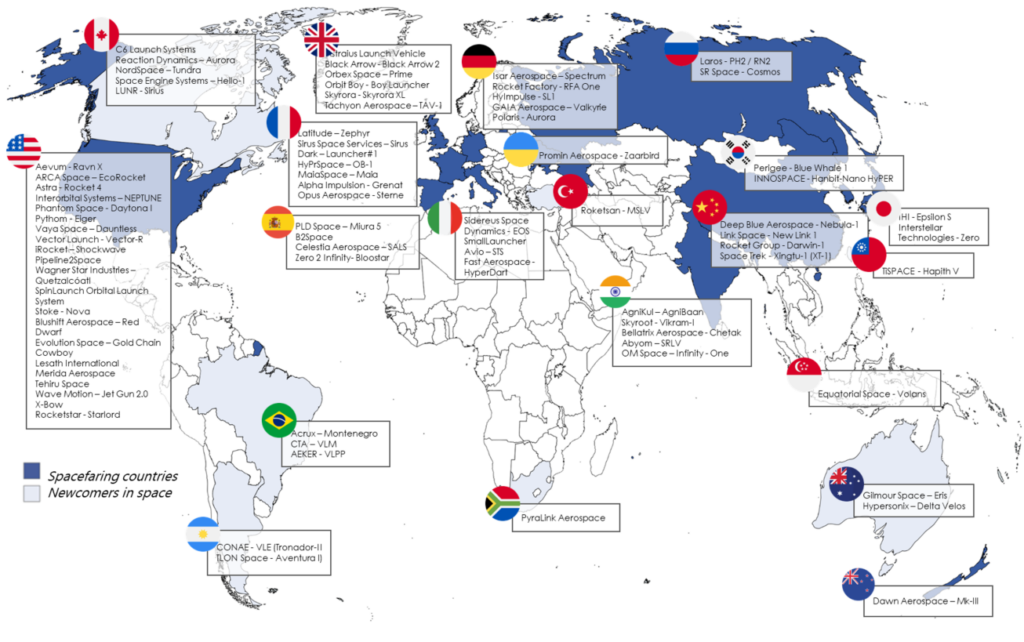The HCoC and New Technologies
HCoC Issue Brief – January 2025
New technologies related to ballistic missiles
Ballistic missiles are relying on an old technology, developed during the Second World War and upgraded during the Cold war. However, the integration of more recent technologies can have implications for arms control and non-proliferation measures related to missiles.
The increase of the range of ballistic missiles, permitted in particular by the generalisation of solid propellant, is a gradual evolution which has repercussions for arms control. Likewise, progressive improvements regarding navigation and guidance have allowed missiles to gain accuracy and to be used for precise conventional strikes. Notably, these technological developments have been largely shared, which means that many actors are now able to field sophisticated missiles.
In the future, artificial intelligence will greatly influence targeting and have an effect both on the ways missiles are used and the demand for some systems.i Tracking and destroying missile systems while they are being stored, moved or prior to use would be enabled due to the availability of satellite images and the possibility to conduct big data analysis through AI.ii The combination of AI and accuracy in developed systems will therefore create some vulnerabilities deep into states’ territory and feed the need for ballistic missile defence, fuelling a negative spiral between offense and defence.
Finally, one of the most high-profile development concerns the efforts of some states to develop hypersonic vehicles. Commonly referred to as ‘hypersonic missiles’, these systems include hypersonic cruise missiles and hypersonic gliders that need a ballistic booster to propel them into space. As glide vehicles bounce back on the atmosphere and glide independently for a long part of their flights, they may no longer qualify as ballistic missiles and therefore no longer be concerned by the regulations existing on this type of weapons.iii
In brief
In the field of arms control and non-proliferation, ‘emerging techno-logies’ are commonly perceived as creating potential threats that may make it even more difficult to prevent arms racing and regulate global competition.
Regarding missiles, several specific technological developments may have an impact on the functioning of export control regimes and confidence-building measures, such as of flight characteristics, and in particular the development of hypersonic manoeuvring vehicles, or the introduction of new navigation and guidance techniques.
Given the dual-nature of the Hague Code of Conduct, space developments must also be considered to assess the adaptability of the regime to new technologies.
Author: Emmanuelle Maitre

Technological developments do not concern only the way missiles operate but also the way they are built. Additive manufacturing, also known to 3D-printing, enable the creation of increasingly sophisticated pieces. It may contribute to the dissemination of some components and parts, whose production specificities can be exchanged more easily through intangible transfers than manufactured items.iv
Evolutions in the space domain
In space as well, many develop-ments will have important consequences, even if to that day, most evolutions are not as much linked to emerging technologies per se but are rather adaptations to space launchers of technologies used in other domains. This is the case for instance of new launching practices, such as launching from sea-based barges, mobile launchers or from planes. It is also the case the use of solid propellant for the main engine of space rockets, a practice which remains limited but carries some proliferation concerns as it was reserved in the past to ballistic missiles.v
At the industrial level, a vast number of start-ups or new companies aim at launching objects in space (figure 2.). It is unsure whether most of these companies will succeed,vi but if some reach space, it will create new patterns of launches, with very small rockets in particular being used for suborbital flights.
More innovative, the effort of some companies to develop fully reusable launchers is an important development which introduces a new class of launching devices. SpaceX’s Falcon 9 and Rocket Lab’s Electron have already managed to recover the first stage of their launchers. SpaceX’s Starship is the first fully recoverable launcher tested, at suborbital altitude to this day.


What developments for the Code
While the Missile Technology Control Regime (MTCR), as an export control instrument, has to ensure that its controlled lists of items are up-to-date and include the most recent technologies used for the production of missiles, the HCoC offers a form of flexibility since it requires restraint and transparency regarding ballistic missiles and space-launch vehicles regardless of the technologies used. However, some of the new technologies evoked above have an influence on the Code.
Hypersonic gliders, as long as they rely on a ballistic booster for a substantive part of their flights, fall within the scope of the Code and should be reported accordingly. This is for instance the case of Russia’s Avangard glider, which has been coupled in previous tests to the ICBM UR-100NUTTKh / SS-19 Mod 4 and R36-M / SS-18 Satan. However, if a glider’s trajectory is mostly non-ballistic, subscribing states may not consider that is meets the criteria of a ballistic missile as understood in the Code. As some of these systems might be developed to carry weapons of mass destruction, it would be useful to integrate them in the scope of the Code.
Regarding the use of AI in missile targeting and tracking, this may have an implication on the willingness of states to display transparency on their systems, as some may rely on concealment to prevent their missiles from being destroyed prior to launch. However, the requirements of the Code in this domain are fully compatible with national security concerns and do not mandate the communication of information on the locations of deployed systems, for instance.
New production practices, such as additive manufacturing and the increase of New Space actors in the launcher business do not have a direct impact on the Code but puts emphasis on the general commitment taken by states to exercise vigilance in transfers and exports in this domain, including when these exchanges are immaterial. The value of this commitment is strong given the high degree of adherence and support to the Code, and the fact that many newcomers in the field of space in particular are subscribing states.
With regard to space, the development of re-usable systems may require a small modification in the text of the Code which to this date refers to ‘expandable space launch vehicle’ in the list of objects on which transparency measures may apply. Since there is no justification to leave out re-usable systems from the declaration and pre-launch notifications when they start reaching orbit, a technical and minor modification of the Code may be considered in this regard.
More broadly, it would be useful to define more specifically what falls within the scope of the Code, in particular regarding suborbital launches but also quasi-ballistic missiles, some of which have medium ranges (such as the North Korean KN-23). States could usefully work on common reporting practices, even if this is done in a first step informally by some interested countries, in order to reduce possible contestation on the implementation of pre-launch notifications.
New technologies and practices in the field of missiles are not fundamentally challenging the way the HCoC is currently reducing the risk of ballistic missile proliferation and of misunderstanding linked to tests. However, they call for some adaptations on the scope of the Code to ensure its efficiency in the long run.
About the Hague Code of Conduct
Adopted in 2002, the Hague Code of Conduct against Ballistic Missile Proliferation (HCoC) is a politically binding instrument aiming to limit the proliferation of weapons of mass destruction (WMD) delivery vehicles. Composed of a set of transparency and confidence-building measures, the HCoC is the only existing multilateral instrument to focus on WMD delivery vehicles. The HCoC has reached 145 subscribing states (2024) vs 93 at its inception.
When subscribing to the HCoC, states commit to abide by a set of UN treaties and international conventions on space security; to produce an annual declaration regarding ballistic missile capacities and national policy on non-proliferation and disarmament treaties and instruments; and to deliver pre-launch notifications prior to any missile or space launch. Documents are uploaded onto a dedicated online platform managed by Austria, which acts as the HCoC Immediate Central Contact (Executive Secretariat). Subscription to the HCoC is free of charge.
While subscribing states are asked to exercise ‘maximum restraint’ in the development of ballistic capacities, they are proscribed neither from possessing ballistic missiles nor from pursuing space launch activities. In return, subscribing to the HCoC enables states to gain access to information shared by other subscribing states, and to display their political commitment to non-proliferation and disarmament.
i Nico Luzum and Nicholas Nelson, ‘NATO Must Embrace AI and Autonomous Weapons,’ CEPA, 19 July 2022, https://cepa.org/article/nato-must-embrace-ai-and-autonomous-weapons/
ii Julian I. Jones II, Russell Kress, William J. Newmeyer Jr., and Adam I. Rahman, Leveraging Artificial Intelligence (AI) For Air And Missile Defense (AMD): An Outcome-Oriented Decision AID, Naval Postgraduate School, September 2020, https://apps.dtic.mil/sti/trecms/pdf/AD1126470.pdf
iii Emmanuelle Maitre and Stéphane Delory, ‘Hypersonic missiles: Evolution or revolution for missile non-proliferation and arms control instruments?,’ HCoC Research Papers n° 12, FRS, February 2023, https://www.nonproliferation.eu/hcoc/wp-content/uploads/2023/03/Hypersonic-weapons-non-proliferation-and-arms-control.pdf
iv Kolja Brockmann and Robert E. Kelley, ‘The Challenge of Emerging Technologies to Non-proliferation Efforts: Controlling Additive Manufacturing and Intangible Transfers of Technology,’ SIPRI, April 2018, https://www.sipri.org/publications/2018/policy-reports/challenge-emerging-technologies-non-proliferation-efforts-controlling-additive-manufacturing-and
v Emmanuelle Maitre and Sophie Moreau-Brillatz, ‘The Hague Code of Conduct and Space,’ HCoC Research Paper n°10, FRS, March 2022, https://www.nonproliferation.eu/hcoc/the-hague-code-of-conduct-and-space-2/
vi Christian Maire, ‘The Rise of Small Launchers: What Impact on Ballistic Missile Proliferation?,’ HCoC Research Paper n°13, FRS, April 2024, https://www.nonproliferation.eu/hcoc/the-rise-of-small-launchers-what-impact-on-ballistic-missile-proliferation/





